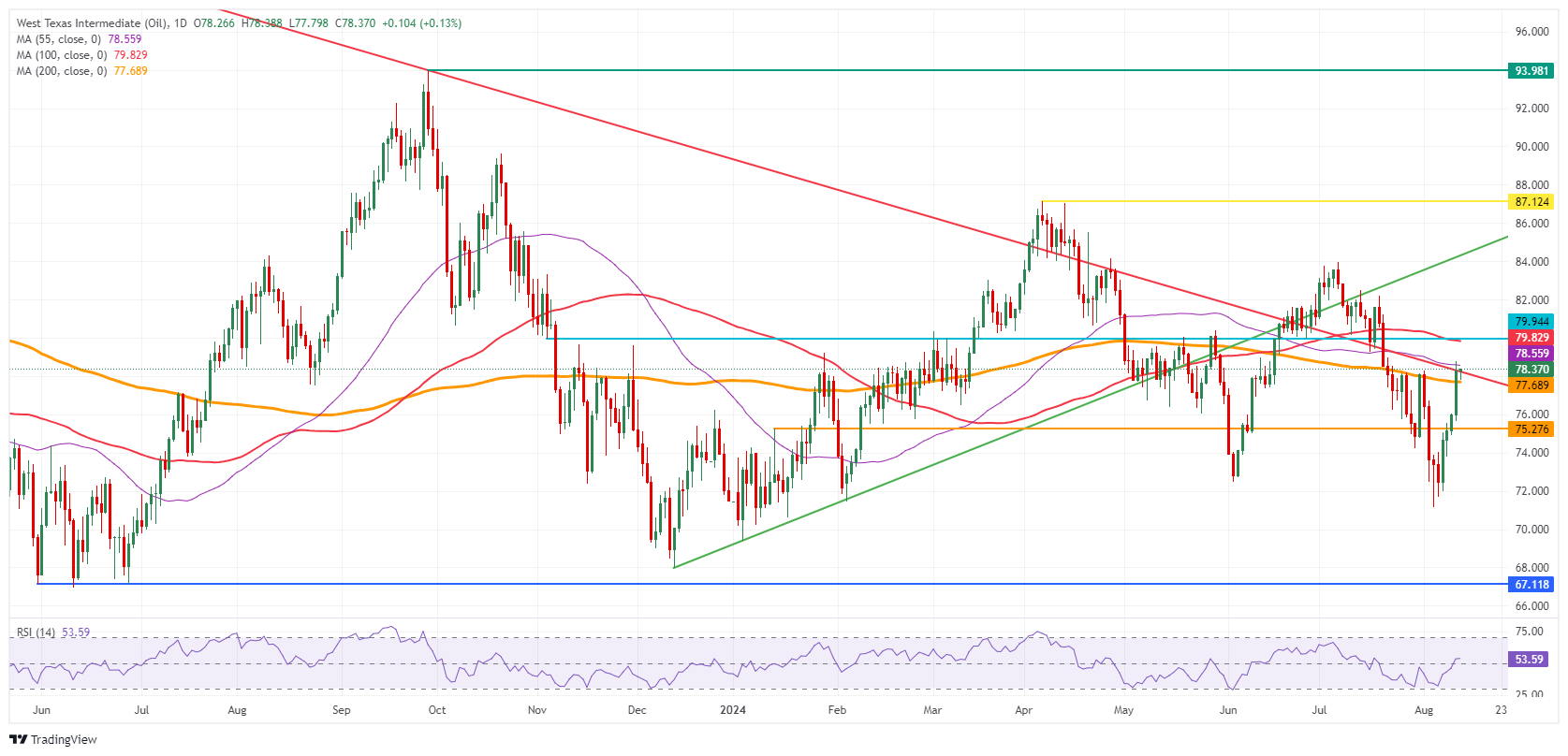- Oil prices extend gains after a minor profit-taking during Asian trading hours.
- Traders sent crude prices nearly 3% higher on Monday even as the OPEC report cut the demand outlook.
- The US Dollar Index is trading at the crucial level of 103.18 after being glued to it since last week.
Oil continues its winning streak for the fifth consecutive session after prices rose substantially on Monday despite a bearish OPEC demand outlook. The International Energy Agency (IEA) is following that narrative, pointing to the risk of a substantial surplus as OPEC prepares to release its production cuts. Still, geopolitical tensions over an impending Iranian attack on Israel are keeping prices supported, and traders appear to be betting that OPEC will deepen its production cuts to continue supporting the black gold.
The US Dollar Index (DXY), which tracks the performance of the US Dollar against six major currencies, is being pulled between two main forces on Tuesday’s trading board. On one hand, last week’s hard-hit carry trades are making a comeback against the US Dollar. On the other hand, the Dollar itself is outperforming the Japanese Yen (JPY). This results in a near-immobility on the DXY US Dollar Index chart ahead of Tuesday’s US Producer Price Index (PPI) numbers and Wednesday’s Consumer Price Index (CPI) release.
At the time of writing, WTI crude oil is trading at $78.25 and Brent crude at $81.40.
Oil News and Market Drivers: OPEC and IEA agree on bearish outlook
- The IEA’s monthly report shows that OPEC output rose by 250,000 barrels per day compared to the previous month. Saudi Arabia and Iraq were the main drivers of the production increase.
- Even if OPEC cancels plans to boost output to normal levels, stocks will build next year by 920,000 barrels a day amid a supply boom from the U.S., Guyana and Brazil, according to the IEA.
- Reuters reports ahead of the American Petroleum Institute (API) numbers that U.S. stockpiles are expected to be depleted with summer demand having peaked.
- The American Petroleum Institute will publish the weekly change in crude oil inventories at 20:30 GMT. The previous number showed a marginal build of just 180,000 barrels.
Technical analysis of oil prices: Risk of rejection
Oil prices have been aiming higher since Monday. The fact that both OPEC and the IEA are seeing a substantial supply surplus has led traders to double down on bets on changes by OPEC, moving away from its commitment to reduce output curbs. Instead, more production could be needed, risking a split within OPEC again.
On the upside, two other important moving averages are very close, with the 55-day simple moving average (SMA) at $78.56 and the 100-day SMA at $79.83. If that 100-day SMA is breached, the $80 area opens up with a final profit target level around $87.12.
On the downside, the 200-day SMA acted as support on some profit-taking in Asia at $77.69. If the price action breaks below it, a quick drop to $75.27 could be on the cards on a sell-off of this rally. A complete retracement at the start of the rally near $72.00 is possible in case of some bearish headlines or catalysts.
WTI Crude Oil Daily Chart
WTI Oil FAQs
WTI crude oil is a type of crude oil sold on international markets. WTI stands for West Texas Intermediate, one of three main types that include Brent and Dubai crude. WTI is also known as “light” and “sweet” for its relatively low gravity and sulfur content, respectively. It is considered a high-quality oil that is easily refined. It is sourced in the United States and distributed through the Cushing hub, considered “the pipeline crossroads of the world.” It is a benchmark for the oil market and the price of WTI is frequently quoted in the media.
Like all assets, supply and demand are the main factors determining the price of WTI crude oil. As such, global growth can be a driver of increased demand and vice versa in the case of weak global growth. Political instability, wars and sanctions can disrupt supply and impact prices. Decisions by OPEC, a group of large oil producing countries, are another key driver of price. The value of the US Dollar influences the price of WTI crude oil, as oil is primarily traded in US Dollars, so a weaker Dollar can make oil more affordable and vice versa.
The weekly oil inventory reports published by the American Petroleum Institute (API) and the Energy Information Agency (EIA) influence the price of WTI oil. Changes in inventories reflect fluctuations in supply and demand. If the data show a decrease in inventories, it may indicate an increase in demand, which would push up the price of oil. An increase in inventories may reflect an increase in supply, which pushes down prices. The API report is published every Tuesday, and the EIA report the following day. Their results are usually similar, with a difference of 1% between them 75% of the time. The EIA data is considered more reliable because it is a government agency.
OPEC (Organization of the Petroleum Exporting Countries) is a group of 13 oil-producing nations that collectively decide on member countries’ production quotas at biennial meetings. Their decisions often influence WTI oil prices. When OPEC decides to reduce quotas, it can restrict supply and drive up oil prices. When OPEC increases production, the opposite effect occurs. OPEC+ is an expanded group that includes ten other non-OPEC countries, most notably Russia.
Source: Fx Street
I am Joshua Winder, a senior-level journalist and editor at World Stock Market. I specialize in covering news related to the stock market and economic trends. With more than 8 years of experience in this field, I have become an expert in financial reporting.








